News games: engaging tools for fighting misinformation
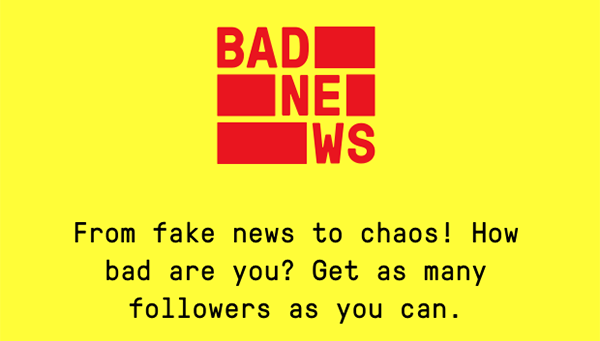
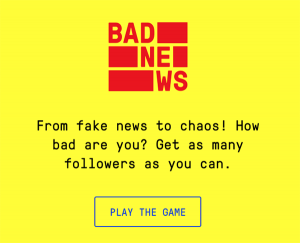 The purpose of Bad News is to gain a social media following while earning six different badges like Emotion and Impersonation. Once a user sets up a fake account he/she can use bots and memes to reach more followers. The game explains these terms before presenting the options. The game always presents different options and gives an explanation of why the one the user chooses works or doesn’t work. The game asks the user to take a survey before beginning (it is optional) and presents the same survey at the end plus demographic info. — Lisa Jackson
The purpose of Bad News is to gain a social media following while earning six different badges like Emotion and Impersonation. Once a user sets up a fake account he/she can use bots and memes to reach more followers. The game explains these terms before presenting the options. The game always presents different options and gives an explanation of why the one the user chooses works or doesn’t work. The game asks the user to take a survey before beginning (it is optional) and presents the same survey at the end plus demographic info. — Lisa Jackson
 Factitious presents a news story and asks the player to click a green checkmark if he/she believes it to be a true story or a red X if not (in the mobile version you swipe right for news and left for fake instead of checkmark and X). There is an option to check the source before voting. If the player is correct, a happy sound plays and the story is moved to the NEWS group. A box pops up stating that the story is news along with a short write-up on the source. If it is wrong, a typical wrong sound plays and the pop-up identifies it as fake and describes why the source is untrustworthy. Correct fake stories go to the left and correct news stories go to the right. There are three rounds and it’s all about identifying legitimate sources. — Lisa Jackson
Factitious presents a news story and asks the player to click a green checkmark if he/she believes it to be a true story or a red X if not (in the mobile version you swipe right for news and left for fake instead of checkmark and X). There is an option to check the source before voting. If the player is correct, a happy sound plays and the story is moved to the NEWS group. A box pops up stating that the story is news along with a short write-up on the source. If it is wrong, a typical wrong sound plays and the pop-up identifies it as fake and describes why the source is untrustworthy. Correct fake stories go to the left and correct news stories go to the right. There are three rounds and it’s all about identifying legitimate sources. — Lisa Jackson
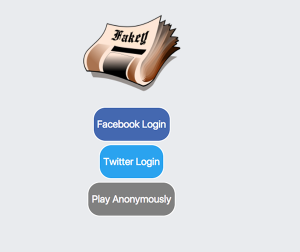 Fakey allows users to engage with a simulated social media feed and pick out which stories are real or fake. Increase points and skill by sharing articles from credible sources and fact-checking non-credible sources. Lose points and skill by sharing or liking from an untrustworthy site or using the hints provided. The format is very similar to what generally pops up on social media sites and made it super simple to navigate. They include actual recent news, for example, the Laurel vs. Yanny debate and North Korea canceling talks with South Korea. — Sayo Akao
Fakey allows users to engage with a simulated social media feed and pick out which stories are real or fake. Increase points and skill by sharing articles from credible sources and fact-checking non-credible sources. Lose points and skill by sharing or liking from an untrustworthy site or using the hints provided. The format is very similar to what generally pops up on social media sites and made it super simple to navigate. They include actual recent news, for example, the Laurel vs. Yanny debate and North Korea canceling talks with South Korea. — Sayo Akao
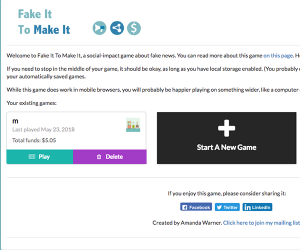 Fake It To Make It is an interesting type of news game. The goal is to produce a successful fake news site by copying and writing fake articles that have a certain score of believability and drama. Players plant the article into a group that then share the post to generate revenue. The aim seems to be to let people see how easily fake news spreads, although I would say that it can be confusing since the actual actions in the game are adding to the spread of fake news. It is also a very long game; I haven’t been able to finish.
Fake It To Make It is an interesting type of news game. The goal is to produce a successful fake news site by copying and writing fake articles that have a certain score of believability and drama. Players plant the article into a group that then share the post to generate revenue. The aim seems to be to let people see how easily fake news spreads, although I would say that it can be confusing since the actual actions in the game are adding to the spread of fake news. It is also a very long game; I haven’t been able to finish.
At first I was confused at to what the goal of the game is. Once I realized that I was actually promoting fake news rather than stopping it, I started to gain a better understanding of the concept. My only problem with the concept is that if I were attempting to tackle the issue, I would look for other ways to show how quickly fake news can spread that wouldn’t have the player be the one spreading the fake news. — Sayo Akao
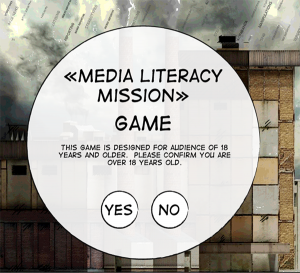 At the start of the Media Literacy Mission, the player is tasked with fighting propaganda, fake news and misinformation with a set number of tools to help inside a backpack. The first “mini-game” has users match the definitions of fake news terminology, which are used throughout the game. It seems like a smart way to impart some prior knowledge that players might not have already had.
At the start of the Media Literacy Mission, the player is tasked with fighting propaganda, fake news and misinformation with a set number of tools to help inside a backpack. The first “mini-game” has users match the definitions of fake news terminology, which are used throughout the game. It seems like a smart way to impart some prior knowledge that players might not have already had.
After unlocking the door to the “Fake News Factory,” players are tasked with walking around three floors to destroy anything that is not factual and credible news. In the first room, the player watches a piece of news and answers follow-up questions to determine if it is actual information or propaganda, so the player can destroy the video disc with the propaganda. Asking the questions makes the player actually evaluate the information they are being presented with rather than simply guessing one option or another.
Players can utilize tools, such as the Logic-o-meter, to help evaluate each piece of information in the different rooms. The game does a good job of actually providing information on concepts like propaganda and advertorials, along with some type of “test” for the player to evaluate what the right answer would be. Finally, players determine the news that needs to be included in the feed for the day, thinking about timeliness, proximity and all the other factors that add to the newsworthiness of a piece.
I was enjoying the game and learning a lot, but unfortunately it froze up after a bit and was stuck on a loading screen to get to the next room. Reloading the entire web page simply took me to the start of the game. Would have loved to finish the tour of the factory! — Sayo Akao

Kristy Roschke, managing director of the ASU News Co/Lab, is a media scholar and educator. Her research interests include misinformation, media literacy education and media trust. Roschke has developed curriculum and taught journalism and media literacy courses at the high school and university level for nearly 20 years.
